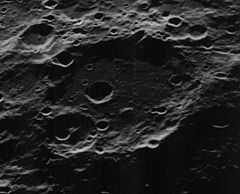Lippmann (crater)
|
Oblique Lunar Orbiter 5 image, facing west | |
| Coordinates | 56°00′S 114°54′W / 56.0°S 114.9°WCoordinates: 56°00′S 114°54′W / 56.0°S 114.9°W |
|---|---|
| Diameter | 160 km |
| Depth | Unknown |
| Colongitude | 119° at sunrise |
| Eponym | Gabriel Lippmann |
Lippmann is a large lunar impact crater in the southern part of the far side of the Moon and so cannot be viewed directly from the Earth. Just to the northeast is the walled plain Mendel, only slightly smaller than Lippmann. To the south-southeast lies the crater Petzval.
As with many lunar formations of this size, Lippmann has been eroded by subsequent impacts. The southeastern part of the rim has been overlain by the satellite crater Lippmann L, which in turn has become worn and eroded. The relatively fresh crater Lippmann Q lies across the southwest rim. The remaining rim has become worn and rounded, with a few surviving terrace-like features and the rim edge having lost their definition. The western and eastern sides of the crater in particular are nearly overlain by ejecta material.
The interior floor is relatively level, at least in the western two-thirds, but is marked by several impacts. The most notable of these is Lippmann P, located just to the southwest of the midpoint. A short chain of small craterlets lies along the southern part of the floor. The remainder is marked by a few small craterlets and pitted by tiny craters.
The terrain to the north and east of this crater are streaked with features that are radial to the huge Mare Imbrium impact basin to the northeast.
Satellite craters
By convention these features are identified on lunar maps by placing the letter on the side of the crater midpoint that is closest to Lippmann.
| Lippmann | Latitude | Longitude | Diameter |
|---|---|---|---|
| B | 52.6° S | 110.9° W | 29 km |
| E | 55.4° S | 107.6° W | 23 km |
| J | 59.0° S | 106.6° W | 19 km |
| L | 57.6° S | 112.5° W | 54 km |
| P | 56.1° S | 115.0° W | 29 km |
| Q | 57.0° S | 118.7° W | 27 km |
| R | 57.2° S | 121.3° W | 37 km |
References
- Andersson, L. E.; Whitaker, E. A. (1982). NASA Catalogue of Lunar Nomenclature. NASA RP-1097.
- Blue, Jennifer (July 25, 2007). "Gazetteer of Planetary Nomenclature". USGS. Retrieved 2007-08-05.
- Bussey, B.; Spudis, P. (2004). The Clementine Atlas of the Moon. New York: Cambridge University Press. ISBN 978-0-521-81528-4.
- Cocks, Elijah E.; Cocks, Josiah C. (1995). Who's Who on the Moon: A Biographical Dictionary of Lunar Nomenclature. Tudor Publishers. ISBN 978-0-936389-27-1.
- McDowell, Jonathan (July 15, 2007). "Lunar Nomenclature". Jonathan's Space Report. Retrieved 2007-10-24.
- Menzel, D. H.; Minnaert, M.; Levin, B.; Dollfus, A.; Bell, B. (1971). "Report on Lunar Nomenclature by the Working Group of Commission 17 of the IAU". Space Science Reviews 12 (2): 136–186. Bibcode:1971SSRv...12..136M. doi:10.1007/BF00171763.
- Moore, Patrick (2001). On the Moon. Sterling Publishing Co. ISBN 978-0-304-35469-6.
- Price, Fred W. (1988). The Moon Observer's Handbook. Cambridge University Press. ISBN 978-0-521-33500-3.
- Rükl, Antonín (1990). Atlas of the Moon. Kalmbach Books. ISBN 978-0-913135-17-4.
- Webb, Rev. T. W. (1962). Celestial Objects for Common Telescopes (6th revision ed.). Dover. ISBN 978-0-486-20917-3.
- Whitaker, Ewen A. (1999). Mapping and Naming the Moon. Cambridge University Press. ISBN 978-0-521-62248-6.
- Wlasuk, Peter T. (2000). Observing the Moon. Springer. ISBN 978-1-85233-193-1.
